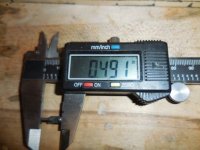rhodesengr
Member
- Joined
- Jul 12, 2021
- Messages
- 129
- Reaction score
- 65
I would like to get some input on light strikes with a 686 Competitor model. I was in an event that requires about 100 rounds. Maybe five of my rounds didn't fire. Some of those fired with a second stroke. One wouldn't fire at all.
If it matters, I was shooting double action.
The revolver is quite new, purchased new earlier this year, and probably has less than 300 round total fired through it.
These are rounds I made myself with CCI primers, Starline brass, and Accurate #5 powder. I showed the FTF round to someone with more experience and he pointed out that the dent from the firing pin looked shallow compared to rounds that fired normally.
I am rather new to revolvers and their inner workings. What I would like to know is can anything be done to improve the firing reliability? Harder strike? Longer strike? Is there an adjustment that can be made? Do I need a different firing pin? Different spring somewhere? The gun is completely stock and I have never taken it apart.
Edit: I did a search and found some videos about the tension screw being loose. I took the grip off and the screw was fully tight. So that won't help in my case.
If it matters, I was shooting double action.
The revolver is quite new, purchased new earlier this year, and probably has less than 300 round total fired through it.
These are rounds I made myself with CCI primers, Starline brass, and Accurate #5 powder. I showed the FTF round to someone with more experience and he pointed out that the dent from the firing pin looked shallow compared to rounds that fired normally.
I am rather new to revolvers and their inner workings. What I would like to know is can anything be done to improve the firing reliability? Harder strike? Longer strike? Is there an adjustment that can be made? Do I need a different firing pin? Different spring somewhere? The gun is completely stock and I have never taken it apart.
Edit: I did a search and found some videos about the tension screw being loose. I took the grip off and the screw was fully tight. So that won't help in my case.
Last edited:




